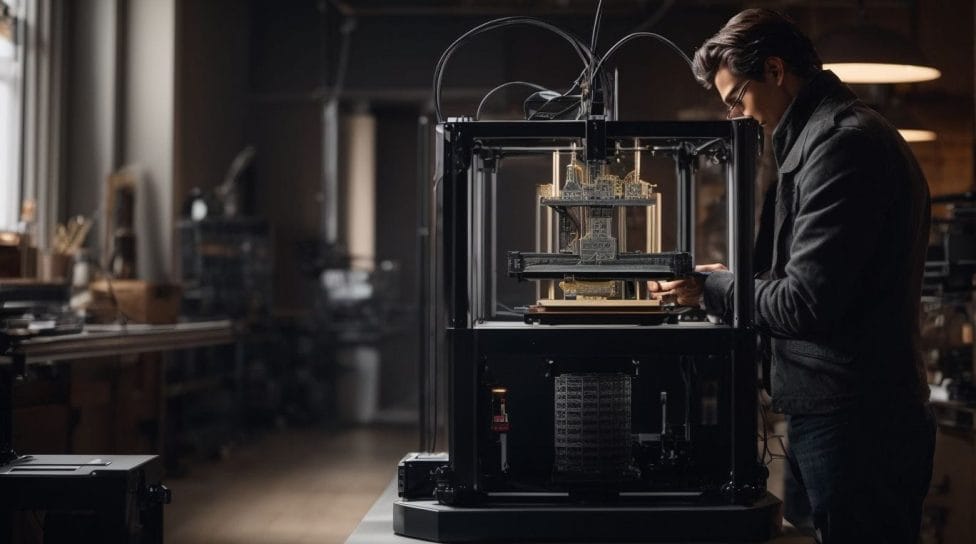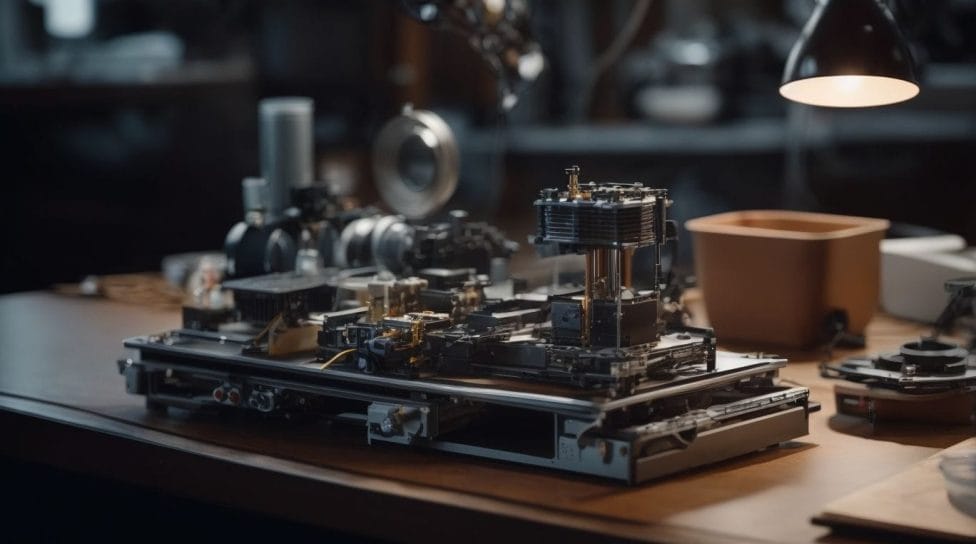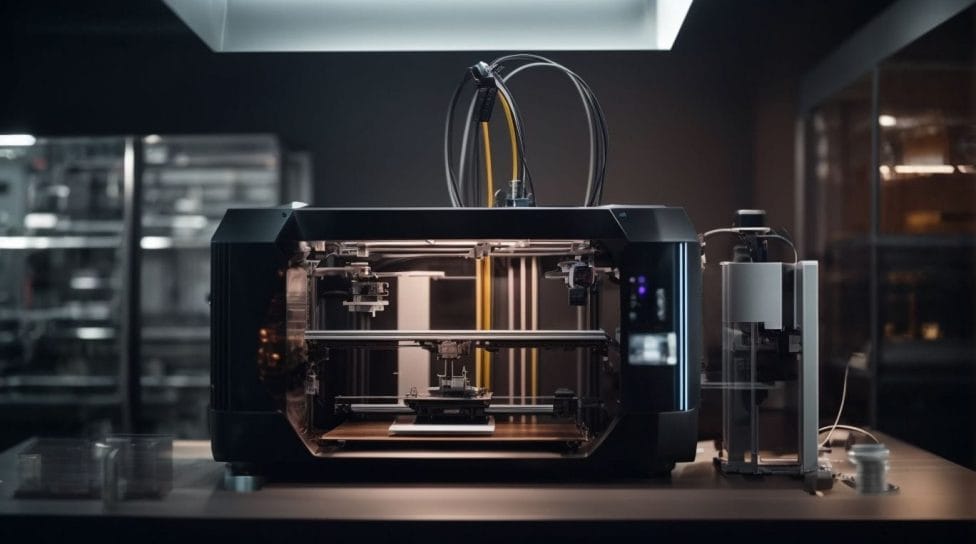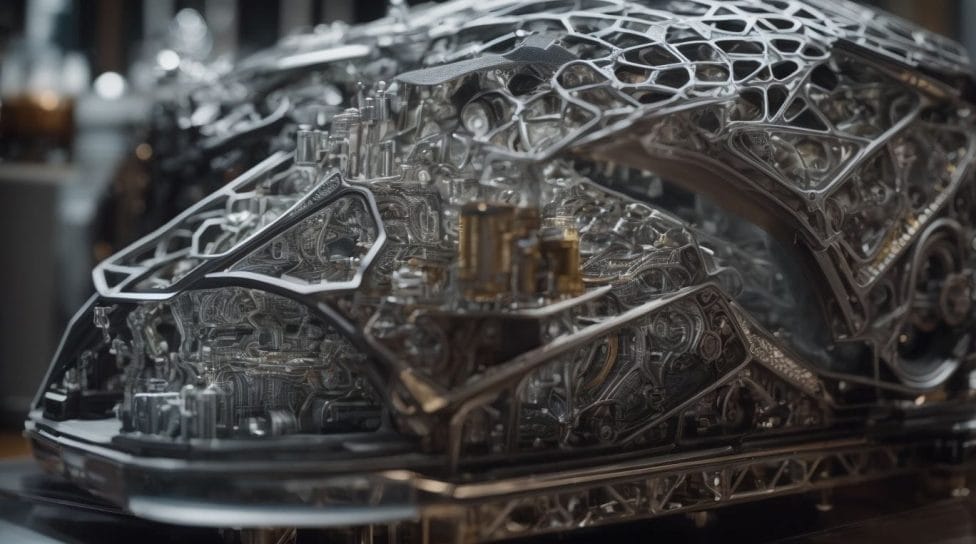3D Printing is a fascinating realm of innovation and technological advancements. Before diving into the inventors and the workings of this revolutionary technology, it is important to delve into its historical background. Early manufacturing techniques paved the way for the emergence of additive manufacturing, which formed the basis of 3D printing as we know it today.
The historical background of 3D Printing provides an overview of the early manufacturing techniques and the emergence of additive manufacturing. Understanding these foundations is crucial to grasp the significance and impact of 3D Printing.
Regarding inventors, Charles W. Hull is widely regarded as the Father of 3D Printing. His contributions and inventions played a significant role in the development and popularization of this technology. Scott Crump’s invention of Fused Deposition Modeling (FDM) revolutionized the field of 3D Printing and made it more accessible to a wider range of industries.
While these inventors made groundbreaking strides, there have been numerous other key contributors and innovators in 3D Printing. Together, their collective efforts have propelled the technology forward, enabling its widespread adoption and application in various industries.
To truly comprehend the workings of 3D Printing, it is essential to grasp the basic process involved in this technology. Furthermore, different 3D printing technologies exist, each employing unique mechanisms and materials.
The impact of 3D Printing on industries cannot be overstated. It has revolutionized manufacturing and prototyping processes, allowing for faster production, cost-efficiency, and greater design flexibility. This technology has also significantly advanced in bioprinting and healthcare, opening up possibilities for personalized medical solutions and tissue engineering. 3D Printing finds applications in aerospace, automotive, and fashion, enabling novel designs, lightweight structures, and improved functionality.
As 3D Printing continues to evolve, the future holds many possibilities. Ongoing technological advancements and innovations promise to expand the scope and capabilities of this technology. However, potential challenges and limitations must also be addressed to maximize the potential of 3D Printing and overcome any obstacles that may arise.
Key takeaways:
- Charles W. Hull: The Father of 3D Printing: Charles W. Hull is credited with inventing 3D Printing and coining the term ‘stereolithography’. His invention revolutionized manufacturing techniques and paved the way for the 3D printing industry we know today.
- Scott Crump and Fused Deposition Modeling: Scott Crump invented Fused Deposition Modeling (FDM), a popular 3D printing technology. FDM allows the creation of three-dimensional objects by applying layers of material. This technique has had a significant impact on industries like prototyping and manufacturing.
- Contributors and Innovators: Alongside Hull and Crump, there have been several key contributors and innovators in 3D Printing. These individuals have played crucial roles in advancing the technology and expanding its applications in various industries.
Historical Background of 3D Printing

Photo Credits: Futureproof3D.Com by Andrew King
3D Printing revolutionized the manufacturing world, but have you ever wondered about its historical background? In this dive into the past, we’ll explore the early manufacturing techniques that laid the foundation for 3D Printing. We’ll also unravel the emergence of additive manufacturing, the ingenious process that brought this game-changing technology to life. Get ready to unravel the fascinating journey behind the invention of 3D Printing!
Overview of Early Manufacturing Techniques
| Overview of Early Manufacturing Techniques | Description |
| Casting | The process is pouring molten material into a mold and solidifying it to obtain the desired shape. |
| Machining | It removes material from a workpiece using various tools and techniques such as cutting, drilling, and shaping. |
| Forming | We are altering the shape of a material through processes like bending, pressing, or rolling. |
The text overviews early manufacturing techniques, including casting, machining, and forming. These techniques were commonly used before the emergence of 3D Printing. Casting involves pouring molten material into a mold and solidifying it to obtain the desired shape. Machining, on the other hand, involves removing material from a workpiece using various tools and techniques like cutting, drilling, and shaping. Forming, on the other hand, allows for altering the shape of a material through processes like bending, pressing, or rolling. However, these techniques had limitations regarding complex designs and material waste. The introduction of additive manufacturing, including 3D Printing, revolutionized the manufacturing industry by enabling precise and cost-effective production of complex solid structures. Given the benefits of 3D Printing, it is worth exploring its adoption to enhance efficiency and develop innovative solutions in various industries.
Emergence of Additive Manufacturing
Additive manufacturing, also known as 3D Printing, emerged as a revolutionary technology in the manufacturing industry, showcasing the emergence of additive manufacturing. It allowed for the creation of solid structures layer by layer, using a low-cost approach. Rapid prototyping and various additive manufacturing technologies paved the way for this emergence.
One notable example illustrating the emergence of additive manufacturing is creating a prosthetic hand for a young girl. Traditional prosthetics were expensive and limited in functionality. With the advent of 3D Printing, a team used additive manufacturing to design and produce a customized prosthetic hand at a fraction of the cost. This technological breakthrough not only improved the girl’s quality of life but also demonstrated the potential impact of additive manufacturing on the healthcare industry.
Who Invented 3D Printing?

Photo Credits: Futureproof3D.Com by Dennis Harris
Are you curious to know the masterminds behind the incredible invention of 3D Printing? Look no further! In this section, we’ll unveil the brilliant minds who revolutionized the world of Printing as we know it—from Charles W. Hull, hailed as “The Father of 3D Printing,” to Scott Crump and his groundbreaking work with Fused Deposition Modeling and not forgetting the other influential contributors who have left their mark on this remarkable technology. Get ready to dive into the fascinating world of 3D printing pioneers!
Charles W. Hull: The Father of 3D Printing
Charles W. Hull, widely known as The Father of 3D Printing, is renowned for inventing Stereolithography in the early 1980s. With this groundbreaking technique, Hull introduced the concept of layer-by-layer printing, using UV light to solidify thin layers of liquid resin and create durable structures. His remarkable work laid the foundation for modern additive manufacturing technologies. Hull’s exceptional contributions to 3D Printing were acknowledged through multiple U.S. patents, and his pivotal role in revolutionizing manufacturing and prototyping cannot be overstated. His pioneering invention has had a significant impact on numerous industries, including healthcare, aerospace, automotive, and fashion. Charles W. Hull is undoubtedly a key figure in the history and development of 3D printing technology.
Scott Crump and the Invention of Fused Deposition Modeling
Scott Crump, credited with the invention of Fused Deposition Modeling (FDM), revolutionized the field of 3D Printing. In 1988, Crump developed this key technology, founding Stratasys, a leading company in the industry. FDM works by melting and extruding thermoplastic materials, allowing for the creation of objects layer by layer. This invention, by Scott Crump, introduced a low-cost and accessible method of creating solid structures. Today, FDM printers are widely used across various industries and by hobbyists. Scott Crump’s innovation not only opened doors for rapid prototyping but also paved the way for the advancements we witness in 3D Printing today.
Other Key Contributors and Innovators in 3D Printing
There have been several other key contributors and innovators in 3D Printing. Here is a table highlighting some of them:
| Contributor | Innovation |
| Carl Deckard | Developed Selective Laser Sintering (SLS) technology, which uses a laser to fuse powdered materials selectively |
| Esther Hull | Contributed to the development of Stereolithography (SLA) technology alongside her husband, Charles Hull |
| Alain Le Méhauté | Co-invented the concept of Rapid Prototyping, which laid the foundation for modern 3D printing techniques |
| Hideo Kodama | Developed the first working prototype of a 3D printer using photopolymer resins and ultraviolet light |
These individuals were crucial in advancing 3D printing technology and contributing to its widespread adoption in various industries.
How Does 3D Printing Work?

Photo Credits: Futureproof3D.Com by Ryan Torres
Discover the fascinating world of 3D Printing and unravel the intricacies of its functioning. Get ready to dive into innovative manufacturing as we explore the basic process of 3D Printing and the various types of technologies used. From layering materials to additive manufacturing, we’ll uncover the secrets behind this revolutionary method. So, fasten your seatbelts and embark on a captivating journey through the inner workings of 3D Printing.
The Basic Process of 3D Printing
The basic process of 3D Printing, known as “The Basic Process of 3D Printing,” involves several steps:
- Designing the 3D model using CAD software.
- Slicing the model into thin layers using software.
- Preparing the 3D printer by loading the necessary materials.
- Printing the model layer by layer, according to the sliced design.
- Cure or solidify the printed layers using UV light or heat.
- Removing support structures, if any, from the printed object.
- Finishing and post-processing the printed object, such as sanding or painting.
Pro-tip: It is important to properly calibrate the 3D printer and choose the right printing parameters, such as layer height and printing speed, for optimal results in the 3D printing process.
Types of 3D Printing Technologies
| Type of 3D Printing Technology | Description |
|---|---|
| Stereolithography | It uses a liquid resin cured using UV light layer by layer to create solid objects. |
| Fused Deposition Modeling | Heats and extrudes a thermoplastic material, depositing layers to build the object. |
| Selective Laser Sintering | It uses a high-powered laser to fuse powdered material layer by layer, creating solid objects. |
Different types of 3D printing technologies have seen the emergence of various printing techniques. Stereolithography involves curing liquid resin with UV light to create solid structures. Fused Deposition Modeling uses thermoplastic material extrusion to build layer-by-layer objects. Selective Laser Sintering fuses powdered material using a laser to form solid objects. Each technology offers unique advantages and applications, revolutionizing manufacturing, prototyping, and various industries. As technology advances, more innovative techniques are expected to emerge.
The Impact of 3D Printing on Industries

Photo Credits: Futureproof3D.Com by Keith Miller
3D Printing has swept across industries, transforming the way we manufacture, prototype, and even heal. In this section, we’ll explore the profound impact of 3D Printing on various sectors. From revolutionizing manufacturing and prototyping to the game-changing advancements in bioprinting and healthcare and its applications in aerospace, automotive, and fashion, we’ll delve into how this technology shapes the future of industries. Get ready to be amazed by the possibilities unleashed by 3D Printing.
Revolutionizing Manufacturing and Prototyping
Revolutionizing manufacturing and prototyping, 3D Printing has completely transformed the way products are designed and created. The use of commercial 3D printers for rapid prototyping has resulted in a significant reduction in development time and costs. Various industry giants have embraced this revolutionary technology to streamline their manufacturing processes efficiently and quickly iterate designs efficiently. In addition, 3D Printing has also made remarkable advancements in bioprinting, enabling the production of medical equipment and driving improvements in healthcare. Moreover, the aerospace, automotive, and fashion industries have also experienced immense benefits from the versatility offered by 3D Printing, which allows for customization and efficient production. With the continuous advancement of technology, it is evident that additive manufacturing and 3D Printing will continue to bring about revolutionary changes in multiple industries.
Advancements in Bioprinting and Healthcare
Advancements in bioprinting and healthcare have completely transformed the medical field. Bioprinting technology has revolutionized the creation of three-dimensional structures using living cells, opening up endless possibilities for tissue engineering and organ transplantation. Dedicated researchers focus on printing fully functional organs such as kidneys and hearts, ultimately tackling organ shortages. Furthermore, bioprinting has proven invaluable in designing customized medical implants and prosthetics, vastly enhancing patient outcomes. It’s important to note that the healthcare industry has also experienced significant benefits from 3D Printing, which has allowed for the manufacturing of medical equipment and devices with unprecedented precision and efficiency. These remarkable advancements have the potential to completely revolutionize patient care and greatly improve the overall delivery of healthcare services.
Applications in Aerospace, Automotive, and Fashion
| Applications in Aerospace and Fashion | Applications in Automotive and Fashion | Applications in Fashion |
| 1. Rapid prototyping of aircraft parts | 1. Customization of car interiors | 1. Design and production of unique fashion accessories |
| 2. Manufacturing lightweight components for spacecraft | 2. Production of complex engine components | 2. 3D printed clothing, footwear, and customized jewelry |
| 3. Creation of intricate aerospace models for testing | 3. Prototyping and manufacturing of automotive prototypes | 3. Customized jewelry and luxury items |
3D Printing has revolutionized various industries, including aerospace, automotive, and fashion. In the aerospace sector, it allows for rapid prototyping of aircraft parts and the manufacturing of lightweight components for spacecraft. In the automotive industry, 3D Printing enables the customization of car interiors and the production of complex engine components. In the fashion industry, it facilitates the design and production of unique fashion accessories, 3D-printed clothing, footwear, and customized jewelry. The versatility and innovation offered by 3D Printing continue to impact these industries, opening up new possibilities for manufacturing and design.
As the technology advances, there are suggestions for further exploration in these industries. For aerospace, further research can focus on developing 3D-printed components that are strong and durable enough for actual use in aircraft. In the automotive field, exploring the potential for 3D-printed electric vehicle parts and improved structural components can be beneficial. In fashion, experimenting with sustainable materials and expanding the range of customizable fashion items can be exciting areas to explore. With ongoing advancements in 3D printing technology, the possibilities for these industries are endless.
The Future of 3D Printing

Photo Credits: Futureproof3D.Com by Joseph Roberts
With ongoing technological advancements and innovations, as well as potential challenges and limitations, the future of 3D Printing holds immense potential. From pushing the boundaries of manufacturing to revolutionizing healthcare and even reaching outer space, this section explores the exciting possibilities that lie ahead. Get ready to dive into 3D Printing and discover how it is reshaping industries and opening doors to endless creativity.
Ongoing Technological Advancements and Innovations
Ongoing technological advancements and innovations are at the forefront of driving the future of 3D Printing. These continuous improvements encompass enhancements in materials, printing speed, and accuracy, along with the exploration of new printing techniques. For instance, researchers are actively investigating the utilization of nanomaterials and biocompatible materials for various applications in 3D Printing. Furthermore, the integration of artificial intelligence and machine learning boosts the capability of 3D printers to create intricate and precise designs. With the ongoing evolution of technology, we can anticipate witnessing even more revolutionary innovations in 3D Printing that will reshape industries like manufacturing, healthcare, and aerospace. The possibilities are truly limitless!
Potential Challenges and Limitations
| Potential Challenges and Limitations | Limitations |
| 1. Material Limitations | 2. Size Constraints |
| 3. Printing Speed | 4. Post-processing Steps |
| 5. Cost of Equipment and Materials | 6. Intellectual Property Concerns |
| 7. Quality and Accuracy | 8. Environmental Impact |
Although 3D Printing offers numerous advantages, there are also Potential Challenges and Limitations to consider. Material limitations can restrict the range of objects that can be printed, while size constraints may impact the Printing of large-scale items. Printing speed and post-processing steps can contribute to longer production times. The cost of equipment and materials can also be a barrier, and intellectual property concerns must be addressed. Maintaining quality and accuracy, as well as addressing environmental impact, are ongoing considerations in the advancement of 3D printing technology.
Despite these Potential Challenges and Limitations, solutions and improvements are being explored. Advances in materials research, faster printing technologies, and more efficient post-processing techniques are being developed. Efforts to reduce costs and address environmental concerns through sustainable practices are underway. Continuous innovation and collaboration among industry professionals can overcome these challenges and propel the future of 3D Printing.
Some Facts About Who Invented 3D Printing:
- ✅ 3D Printing originated in 1981 with the invention of a rapid prototyping machine by Dr. Hideo Kodama.
- ✅ Chuck Hull filed the first patent for Stereolithography (SLA) in 1986, making him known as the inventor of 3D Printing.
- ✅ In 1988, Carl Deckard licensed selective laser sintering (SLS) technology, and in 1989, Scott Crump patented fused deposition modeling (FDM) and founded Stratasys.
- ✅ The 1990s saw significant growth in the 3D printing industry, with new companies and additive manufacturing technologies emerging.
- ✅ Makerbot, founded in 2009, played a significant role in bringing 3D Printing to the mainstream market.


